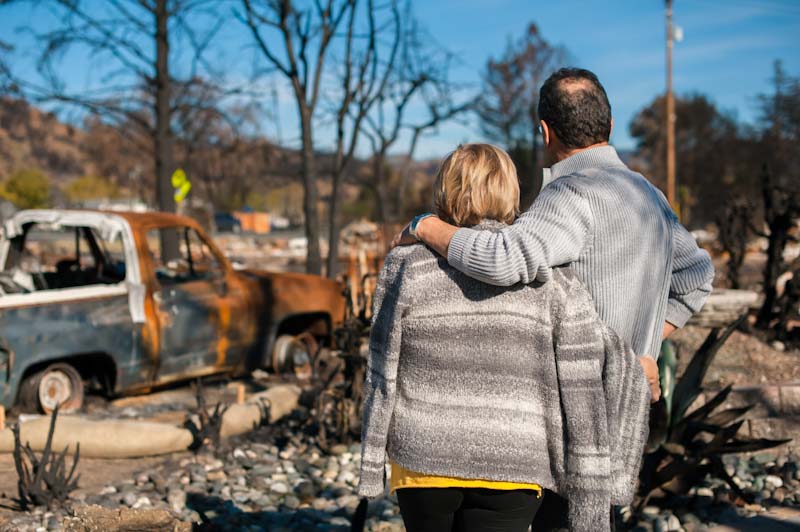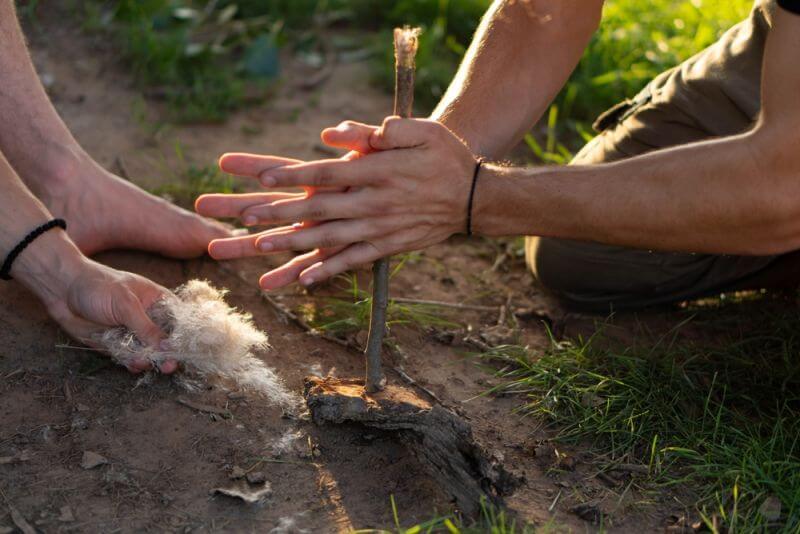The bug-in/bug-out debate has been around the block a few times in the prepping and survival community. Most people today say that its best to bug in, rather than bugging out. Without getting into the whole discussion, allow me to just say that I agree with that assessment in most cases. As we all know, there are always exceptions, which explains why we all need a solid bug out plan.
But as with many things, there’s a good chance that our understanding of bugging in is probably just a bit idealistic. We tend to see ourselves living in our homes, just as they are now, but without electricity and running water. There’s a pretty good chance of something like that happening, so that’s not too bad an image to have. But what if it doesn’t work out that way? What if your home is seriously damaged by whatever disaster you find yourself living through?
It’s not unusual for natural disasters to damage homes, so what I’m suggesting isn’t a crazy scenario that’s not likely to happen until after the next zombie apocalypse. It really doesn’t take all that much to have windows blown out or a tree limb fall on your roof. Either one can be rather serious; but does that mean that you have to abandon your home? I think not.
On the most basic level, our homes are nothing more than shelter. That means something that protects us from the wind, rain, and cold. Everything else our homes do for us is secondary to that basic function. As long as it can still protect us from nature, our home is still usable, even if it might not seem as elegant or comfortable as normal.
Be Ready to Repair
One of the things we need to be ready to do, as part of our prepping, is repair our home from the damage which might occur during a disaster. I’m not talking about the house burning down here, nor am I talking about returning it to its pristine condition, making it look new again. I’m talking about emergency repairs that might be necessary, if something happens to compromise our home’s ability to provide basic shelter.
Windows
Broken and damaged windows are probably one of the more common problems in a disaster. Glass is much more fragile than the forces of nature which might attack it. When that glass breaks, we need something to cover the holes. That something need not be anything more than sheet plastic and duct tape. We can cut pieces of the plastic off the roll and tape them in place for a temporary window, which will keep the rain out and help keep the wind in.
In the case of needing that jury-rigged window repair to withstand high winds, it will be necessary to put something across the plastic, much like the rails and stiles commonly found in windows. This can be done with thin strips of wood (3/4” square cross-section) on the inside of the plastic. As long as the wood strips are well-attached to the wood framework around the window, they should be able to withstand a fair amount of wind.
Of course, that won’t do much good against hurricane-force winds. For those, you’ll need to cover the windows with plywood, much as people have done for years to prepare for a pending hurricane. Another option, which takes some time and preparation, is to install window security film before the hurricane comes. That will help keep the window from breaking and hold the glass in place if it cracks. If you’re going to do that, you really need to do it at least two weeks before the storm, so that the film has time to dry.
Roofs
Hail damage to roofs is pretty commonplace. Should that happen in your area, you’ll probably be visited by more than one roofer, looking to make a quick buck from your homeowner’s insurance. But it will take some time for them to get your home repaired, as they will be overwhelmed with work.
What that roofer is going to do in the mean time is cover your roof with blue plastic tarps. As long as the tarp is installed so that it goes over the roof’s peak and is secured in a way that the fasteners won’t pull through, it will last for several months, even in fair winds.
You can do this yourself, rather than waiting for a roofing company to come around. All that you really need, besides the tarps and some nails, is something to use as washers, so that the nail heads don’t pull through the tarp. Furring strips, drywall shims, roofing washers or even bottle caps can be used for this.
But what if you get more serious damage to your roof, such as a tree limb falling on it? That will most likely do more than just mess up the shingles. Chances are the limb will break through the roof and cause serious damage to the trusses, even if it doesn’t fall all the way to the floor. In such cases, it’s quite possible that the room will still be usable and the roof can still be covered with a tarp as a temporary repair. But you’ll be better off if you can cut the limb up and get it off the house, then cover the broken part of the roof with plywood, before putting the tarps on.
Staying in the Damaged Home
While it may not be legal to stay in a home that’s suffered damage, I wouldn’t abandon it unless they forced you to. Damaged homes are easier to break into, allowing the looters who always come out during times of disaster an easy target. Even if you have to abandon a room due to damage, you should still be able to use the rest of the house. You may even have power and water.
If you have to abandon a room, you should probably take anything of value and anything you can use to survive out of that room. That’s especially true if the damage makes the room easy to break into. But even without that, there are likely to be things in that room you’ll need and you don’t want the weather to ruin them.
Water Leaks
One serious problem that can go along with damage to your home, is damage to the water pipes. Should that happen, you’ll most likely have to shut off the whole house valve, at the point where the water enters your home. If you don’t, the water department will shut off water at the meter, leaving you in even worse shape.
If you can keep the water department from shutting off your water, you can either cap the water lines that are leaking or cut the main water line after the whole house valve, giving you access to water. Which one of those you do will depend mostly on how much damage there is to your plumbing. You should be ready for both, with the tools and parts necessary. That way, you’ll still have water, even if you have to draw it with a bucket and hose.
Electrical Shorts
Damage to your electrical wiring can be even more serious, as it can cause electrical fires. The simple solution for this is to just turn off the circuit breakers for the affected rooms. This is a good reason to take the time to test all your circuit breakers and mark them on the panel, so that you’ll know which breakers are for what rooms in your home.
As you’re doing this, you want to find the electrical circuit that’s closest to the panel. That’s the one which is the least likely to suffer damage. Should you have to shut pretty much everything down, there’s still a good chance that this circuit will work, giving you access to electrical power.
Make sure you have plenty of good extension cords, as well as splitters. You want cords which will be long enough and of high enough a wire gauge, that you can use them for things like running the refrigerator and running power tools.
If the Damage is Severe
Severe damage might make it seem that you have to leave your home; but I contend that such a decision isn’t automatic. The basis for deciding whether to bug in or bug out is always which will give your family the greatest chance of survival. So, the question really boils down to whether or not you have someplace to go to, where you will be better off than at your home. If all you have is someplace to camp out, for example, then you might as well camp out in your own backyard.
This has happened before, when people wanted to stay at their home, even though the house was demolished, just so that they could keep looters from stealing everything that’s left. Your home is filled with things that not only can help you survive, but also can help you rebuild your life. Camping out in your backyard may not be the most comfortable option available, but if it helps you with salvage operations, it might be worth doing.
The two things we just talked about, with water and electricity, apply in this case as well. Your home’s plumbing and electrical systems may be in such bad shape that you have to pretty much shut everything down; but you might still be able to get water and electricity at the source, making your backyard camping a bit more comfortable.
Remember, no matter what, your home is still your home. While it might suffer damage and even suffer severe damage, it is still the place where you have your belongings, including your survival stockpile. With that being the case, you really don’t want to abandon your home, unless you are really forced to.










David | May 31, 2023
|
Make life interesting. Have some thorn bush and Hawk thorn and bramble over to the old homestead, Hickory And holly could be your next best friend if you have a bar trap or two, It may keep your Neighbor honest, And have an Old Junk car or two use one for a front door or back to the stone age If you use the hood or truck know now would see. as long as there is weeds and no flat grass. A deadfall or two will keep your path clear. If you got an old milk truck slide out the freezer. It won’t look like your bugging in If you have no friends.
Agatha C. | December 14, 2024
|
The damage done to western North Carolina by Hurricane Helene should make everybody start rethinking their “bugging in” scenarios. The flood waters came with very little, if any, notice and knocked houses right off their foundations as well as causing mudslides and washing out entire yards and roads. All the prepping in the world would not have helped many of the folks there. Whatever folks had was swept away with their houses.
A year ago, the town 25 miles away from me was heavily damaged by a tornado. There was no warning. The funnel cloud was headed east across open range, then suddenly turned south and went through the middle of town. Fortunately, it only hit a few buildings directly but it leveled a motel, half a restaurant, a brand new store, the electrical substation for the entire town and 5 houses. 4 lives were lost. When the dust cleared, the houses that were hit were flattened except for the concrete block room that had been added to one of them. The family survived unharmed because they ducked in there as soon as they heard the sirens go off. The elderly woman next door was not so lucky. Nor was a guest in the motel and a customer in the store. All the planning and stockpiling didn’t have any effect. It was all lost in an instant.
Wildfires, tsunamis, flooding, avalanches, mudslides, storms, volcanoes, earthquakes – Mother Nature has come up with quite an assortment of ways to spoil “the best laid plans of mice and men.”. And just about every place on earth is susceptible to at least something she can come up with. Mother Nature’s surprises are probably much more likely to happen than the Zombie Apocalypse.
Remember: You should always have a Plan B and a Plan C.